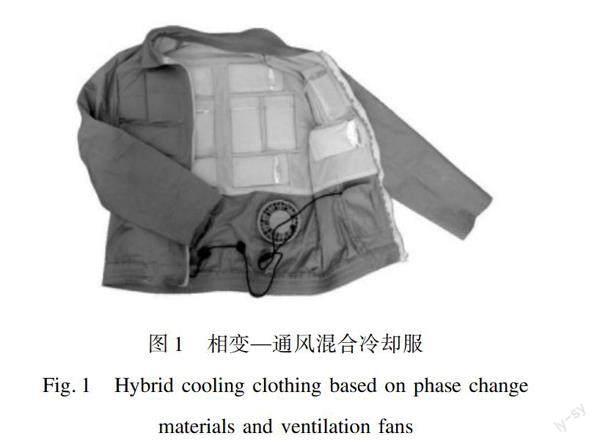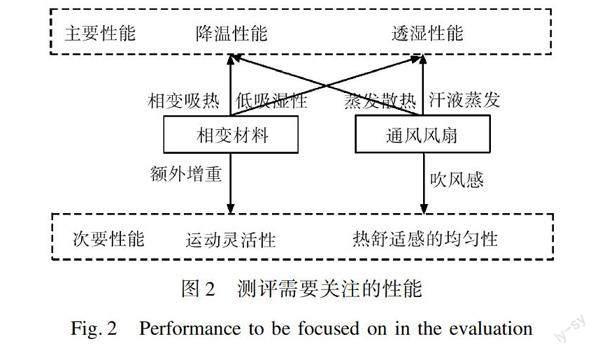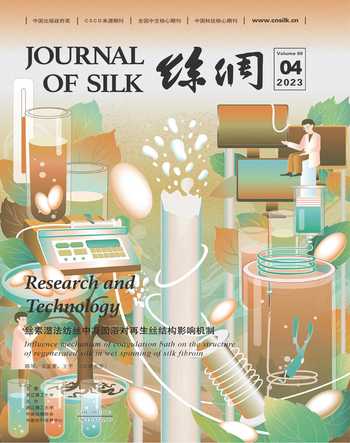相变—通风混合冷却服的冷却效果及其测评方法进展
吴珺秋 李俊


摘要: 相变—通风混合冷却服中两种介质之间存在相互影响,作用机制复杂。本文从冷却介质、服装、人体和环境四个方面剖析了影响冷却效果和着装热湿舒适性的关键因素,发现各因素对冷却效果的交互影响还未得到细化研究,且忽视了服用性能方面的影响。同时,分析了不同测评方法在相变—通风混合冷却服中应用时的适用性及局限性,研究表明物理实验采用的方法、程序和指标的不同会影响测评结果,数值模型存在简化热湿传递和通风过程等不足。本文提出未来的研究可以综合考虑多方面因素对冷却效果的交互影响,探寻兼顾冷却和服用性能的冷却服参数设计;对冷却效果的测评则应考虑建立更加标准化的物理实验测试方法与综合评价体系,并完善对衣下空气层形态、空气流动及热湿传递过程的数值模拟。
关键词: 相变材料;通风风扇;混合冷却服;冷却效果;影响因素;测评
中图分类号: TS941.731
文献标志码: A
文章编号: 1001-7003(2023)04-0071-09
引用页码:
041110
DOI: 10.3969/j.issn.1001-7003.2023.04.010(篇序)
人体在高温环境下长时间作业时,除自身代谢产生热量升高外,人体与环境之间的温差也导致人体向外散热变得困难。此时,仅通过自身体温调节机制无法满足维持热平衡的要求,随之可能产生的热应激不仅会降低作业效率,还威胁到人体健康和安全[1]。因此,各行业在高温环境下作业的热安全性已成为广泛关注的问题。在无法使用空调系统等环境冷却措施时,在服装中增加冷却介质就成为有效的降温手段。根据冷却介质的不同,冷却服可分为液冷服、相变冷却服、对流型和蒸发型气冷服。液冷服和对流型气冷服通过制冷液或预冷空气与皮肤表面之间的温差传热带走热量,但由于制冷装置庞大使得使用者活动受限[2],目前只在少数的特定场景下有一定应用。蒸发型气冷服通过小型通风风扇促进衣下空气对流,增强汗液蒸发散热,具有节能、便携、可手动调节风速等优点,但过度依靠蒸发散热会存在人体脱水的风险[3]。相变冷却服通过固液相变过程吸收人体热量,相变材料包可循环使用,但其可携带数量限制了制冷时间且增加了人体负荷。
为了提升综合冷却效能,有学者开发了相变—通风混合冷却服[4]。然而,当气体和相变材料两种冷却介质共存时,其冷却作用不是简单叠加,两者会产生相互影响。相变材料在吸收热量的同时,也增加了冷却服的热阻和湿阻,对通风散热提出了更高的要求,而利用通风的蒸发散热则会加速相变材料熔化,缩短其作用时间[5]。因此,相对于单一介质的冷却服而言,相变—通风混合冷却服的性能开发涉及多方面的影响因素,其性能评估和预测也更为复杂。
国内外学者已经针对基于相变材料和通风风扇的冷却服展开了大量研究。不仅积极研发新型相变材料和微型风扇以提升冷却服的便携性和服用性能[6],还对比了两种冷却介质的工作机理、优缺点和适用条件,以寻求优势互补,研发混合冷却服[4,7]。同时进一步深入挖掘冷却介质、服装构成、人体特征、环境条件等因素对冷却效果的影响机制,不断优化冷却服的参数设计,完善冷却策略[8-10]。然而,关于多因素影响下的相变—通风混合介质的冷却机理的揭示还不够深入,这也影响了针对性强的测评方法的建立,测评程序和指标的规范性仍有待提高。
本文在提炼相变—通风冷却服性能特征的基础上,通过文献回顾,逐一讨论冷却效果的影响因素及研究进展,在此基础上分析不同测评方法的差异、局限和发展方向,以期为相变—通风冷却服的产品开发、性能优化及效果评估提供参考。
1 性能特征概述
相變—通风混合冷却服由相变材料、通风风扇、内层和外层织物组成,相变材料常以材料包的形式置于内层织物上口袋内,使用电池供电的小型通风风扇通常安装于下背部的外层织物上,如图1[4]所示。相变—通风混合冷却服通过影响人体与环境之间的热湿传递实现对衣下微气候的降温和除湿,使其保持在舒适范围内[11]。
如图2所示,相变材料的热量的吸收能力依赖于材料数量及其相变温度,但材料量的增加会加重人体生理负荷并影响肢体运动灵活性。一方面,相变材料的低吸湿性能会降低服装的透湿能力,导致衣下微气候湿度升高而产生不适感[7],且由于限制蒸发散热而对冷却效果产生负面影响[10]。另一方面,通风风扇能够促进人体蒸发散热并降低微气候湿度,提升冷却服的热湿传递性能,但其所发挥的作用不仅与气流温度和通风量相关,而且与服装衣下空间特征及服装开口设计有关。但通风气体在人体表面流动会产生吹风感,引起局部和整体热舒适感的不均匀,且不适用于人体低汗液分泌、高湿度环境等湿度差较小的条件[7,12-13]。两种冷却介质混合使用时,不但会产生累积效应,大幅提升冷却服的整体冷却效果,而且会产生交互作用,优势互补,如相变材料的低吸湿性引起的问题可以经由通风策略得到缓解。可见,相变—通风冷却服的冷却效果受到冷却介质各参数、服装构成、环境参数等诸多因素的影响,对其冷却性能的评价也涉及人体降温量和降温速度、衣下空间的温湿度、人体皮肤表面湿度、主观舒适感等多方面的指标。
2 冷却效果影响因素研究
2.1 冷却介质的影响
2.1.1 相变材料
相变材料的熔化温度是影响其冷却效果的主要因素之一。Gao等[14]研究了熔化温度与皮肤之间温度差对冷却速率的影响,结果显示温度差越大,冷却速率越大。有研究表明,提高相变材料的熔化温度和潜热可以延长冷却持续时间,在高温环境中高熔点相变材料不足以从人体中吸收足够热量来缓解热应激[15]。然而,熔化温度过低会造成皮肤出现红斑的过冷现象[16],且低熔点相变材料通常具有低熔化潜热和高液态密度,存在冷却时间短、额外增重大、蓄冷耗能多的缺陷。因此,Zheng等[17]提出多熔点相变材料的复合应用,采用15 ℃和23 ℃熔点的相变材料分别作为内层和外层,在加快冷却速率的同时延长冷却持续时间。Itani等[18]提出,在不同工作阶段选用不同熔点相变材料的阶段冷却策略,在蓄热量较少的初始阶段选用高熔点相变材料,以较低的相变材料重量持续较长冷却时间;工作一段时间后选用低熔点相变材料包及时促进热量散失,缓解长时间工作造成的热应激和知觉疲劳。
相变材料的数量也是介质设置时需要考虑的因素,数量增加会延长冷却持续时间[14,19],但同时也会导致代谢产热和人体工效学方面的消极影响。Itani等[20-21]认为,可以根据实际应用的环境温度和工作时长来调节相变材料添加量。并且,人体躯干的区域性生理特点不同,对冷却的敏感程度和需求也存在差异,将相变材料均匀分配到整个躯干区域不能发挥最大冷却潜力,Itani等[22]研究发现,将相变材料放在对冷却更敏感且出汗量大的背部可获得最佳冷却效果和热湿舒适性。
相变材料透湿性差的特性导致冷却效果与热湿舒适性之间存在矛盾。Reinertsen等[23]研究表明,相变材料覆盖整个躯干时能获得更低的平均皮肤温度,但仅覆盖躯干上部时可以促进衣下空间内水分向外传递,从而降低20%的微气候湿度并改善人体湿舒适性。杨晨雨[24]进一步研究了相变材料分布间隙对冷却效果和透湿性能的影响,发现随着分布间隙量的减小,在增强冷却效果的同时会阻碍水分传递,采用4 mm分布间隙量可以实现相对的综合性能最优化。
2.1.2 通风风扇
通风量是影响对流和蒸发热损失最主要的因素。Yang等[25]研究发现,增大通风量可以加快衣下空气流速,增大对流和蒸发传热系数,从而促进对流换热和蒸发散热。然而,通风量增大到一定程度后,会由于空气流速过快而无法与人体充分接触,继续增大通风量不仅无法有效降低皮肤温度,还会减小冷却效率[26]。Zhao等[27]的研究也表明通风量过高会造成局部皮肤温度和热感觉偏低,导致热舒适不均匀和整体热舒适水平降低。
通风风扇在服装中的位置会对衣下空间内的气流路径产生一定影响。Zhao等[8]对比了风扇分别置于胸部、腹部和背部的冷却效果,结果显示不同位置虽然未对躯干整体热损失产生显著影响,但明显改善了风扇所在区域的通风和蒸发散热效果,且风扇置于腹部时空气流经的体表面积最大,整体冷却效果最佳,因此推荐将风扇置于出汗量和体表面积大的位置。Choudhary等[28]基于计算流体力学(Computation fluid dynamics,CFD)的研究也表明,空气在胸部、腹部等热通量较低的区域循环较少,将风扇置于这些区域可以改善空气循环,实现更均匀和显著的冷却效果。
通风风扇的工作模式也影响着冷却效率。由于在工作期间给风扇电池充电或更换电池会降低工作效率,Yi等[29]认为使用容量较大的电池供电或减少电池输出功率可以延长风扇的运行时间,优化风扇的可用性。Davey等[30]提出间歇通风策略,发现相比于持续通风不仅可以节约能耗和延长冷却持续时间,还对皮肤温度感受器产生了周期性刺激,从而改善人体热感觉。
2.1.3 相变—通风混合
相变材料与通风风扇混合使用时会产生相互影响,因此混合冷却策略极大地影响着冷却效率。Lai等[4]研究表明当运行假人干态测试时,在关闭和开启风扇的条件下相变材料分别提供了283 min和170 min的冷却持续时间,这是因为当皮肤表面湿度小于环境湿度时,运行风扇不仅无法增强蒸发散热,还会由于向微气候引入具有较高温湿度的环境空气而增加人体和相变材料吸收的热量,从而影响降温效果并加速相变材料熔化。Raj等[5]提出在相变材料包外加入膨胀聚乙烯隔热层,以减弱运动初始阶段皮肤表面干燥时运行风扇带来的负面影响,增加相变材料从人体吸收热量的比例,结果显示有效延长了平均皮肤温度上升至35 ℃的时间和相变材料的冷却持续时间。此外,相变材料完全熔化后不仅无法提供冷却效果,还会由于其额外增重而增加人体代谢产热,并阻碍微气候内水分和热量向外传递。Wang等[31]针对两种冷却介质的特性制定了阶段冷却策略,在试验开始的第21 min运行风扇以减少初始阶段环境向微气候的显热传递,提高人体热舒适水平和延长相变材料冷却持续时间,在第71 min及时移除完全熔化的相变材料以减少37.3%的物理负荷和缓解人体知觉疲劳,并改善冷却服的透湿性能,增强通风带来的蒸发冷却效果。
2.2 服装结构的影响
通风促进的环境与衣下空间的空气交换,经由服装开口进行,受到开口特征的影响。Zhao等[8]在通风服的胸部和背部增加了开口设计以增强对流,降低服装蒸发阻力,并分散通风时空气从领口、袖口等自然开口排出的压力,减小服装膨胀度,提高穿着者运动灵活性。相变冷却服为了减少环境向相变材料的热传递,通常不增设开口,陈柔羲[32]采用立领作为领口闭合形式以形成烟囱效应,实现空气靠密度差和热湿差的作用从领口快速排出,促进人体产热传递到环境。
服装合体性直接决定了衣下空间的大小,从而影响微气候内空气的流动能力。Yang等[25]研究表明通风冷却效果取决于服装尺寸和通风量的综合影响,当通风量一定时空气流速随着衣下空气层厚度的增大而减小,因此较为宽松的服装可以实现空气与人体的充分接触,产生更显著的冷却效果。
2.3 人体活动的影响
人体活动水平决定着代谢产生热量和皮肤表面出汗量的多少。一方面,人体实际热量散失需求影响着冷却介质的选择,Lai等[4]研究表明人体活动水平较低(1.5 MET)时使用单一的通风或相变冷却方式即可有效减轻身体热负荷,使用混合冷却方式会使人体产生过冷感。另一方面,出汗量与蒸发热损失有着紧密联系,Bachnak等[9]研究发现随着活动水平的增加,通风引起的汗液蒸发热损失明显大于环境向微气候的显热传递的时间点提前。此外,人体出汗感觉也会随着出汗量的增加而变得强烈,从而期望更高通风量来增强蒸发散热[33]。
人体运动状态不仅影响着衣下微氣候与环境之间的空气交换,还会使衣下空气层产生动态变化进而影响热传递方式。人体运动时微气候与环境之间会产生空气对流的“风箱效应”,运行风扇可进一步增强对流换热;而当人体休息为静止坐姿时,背部与服装之间的空气层厚度变小,无法形成有效的对流运动,主要热传递方式变为传导和辐射,运行风扇无法有效增强冷却效果[34]。
2.4 环境条件的影响
环境温度直接决定了“人体—服装—环境”系统内的传热方向。当环境温度低于皮肤温度时,风扇和相变材料分别通过人体皮肤与热空气间的温湿度差及与相变材料间的温度差从人体向外散热,采用单一冷却方式即可满足人体热舒适需求[22,35];当环境温度高于皮肤温度时,相变材料从环境中吸热比例增加,对人体的降温效果减弱,而通风则进一步增强环境向人体和相变材料的传热,单一冷却方式无法提供足够的冷却能力,应采用冷却能力较强的混合冷却方式[36]。
环境湿度影响系统内的水分传递过程,进而影响不同冷却介质的适用性。在干热环境中,相变材料会阻碍汗液蒸发这种主要散热方式,并且其冷却能力不足以弥补对蒸发的阻碍[10],而通风可以有效增强汗液蒸发热损失;在湿热环境中,由于皮膚表面与高湿度空气之间的湿度差较小,通风增强蒸发散热的方式会受到限制[1],并且当微气候湿度超过冷凝阈值时会产生水蒸气冷凝,不仅导致了人体明显潮湿感觉和不适感,冷凝释放的热量还会加速相变材料熔化[31]。
3 测评方法分析
在相变—通风混合冷却服的开发和研究中,暖体假人测试法[10]、真人着装测试法[7]和数值模型预测法[19]是测评其冷却效果的主要方法。
3.1 暖体假人测试法
暖体假人测试法是评价服装隔热性能的通用方法,已形成一系列统一标准,如《ASTM F1291—2015》《ASTM F2370—2015》《ASTM F2371—2010》,可用于测试冷却服的热阻、湿阻和冷却功率,评估其热湿舒适性和冷却效果。暖体假人可以在恒皮温(CT)和恒热流(CHF)两种模式下运行,恒皮温模式将假人皮肤温度设定为34~35 ℃,恒热流模式根据模拟的人体活动水平设定假人加热功率,这两种运行模式均未将人体自身的热生理调节功能考虑在内。基于Fanger提出的人体热舒适方程来模拟热调节过程,暖体假人可实现在热舒适模式(TC)下运行,但该模式由于热舒适方程仅适用于热中性条件而使用范围有限[37]。
Lai等[4]在暖体假人恒皮温模式下测评了相变—通风混合冷却服的冷却效果,通过监测冷却服覆盖的躯干区域的热损失来计算冷却功率,但特定条件下的冷却功率无法代表冷却服在不同应用场景中的实际冷却效果。Xu等[38]提出采用暖体假人测得冷却功率后,进一步根据实际的人体皮肤温度、环境温湿度等参数来估算冷却能力。上述研究仅关注冷却介质贡献的热调节能力,而未考虑其对透湿性的影响,韦帆汝等[39]研究表明相变材料包阻碍水分向外传递,显著增大了上身区域湿阻,而运行风扇可以增强微气候与环境间的对流,从而显著降低冷却服总湿阻。尽管恒皮温模式是ASTM标准推荐暖体假人使用的模式,但用于评价冷却服时,却只能采用间接的冷却功率指标,而不能直接获取人体体温下降的结果。
美国可再生能源研究所提出将暖体假人系统与体温调节模型、热舒适模型耦合得到体温调节模式[40],假人皮肤表面的实时热通量用作体温调节模型的反馈,从而预测和调节下一时间段的假人皮肤温度、出汗率、热感觉和热舒适水平等参数[41]。Lai等[4]采用体温调节模式比较了人体处于低等(1.5 MET)和高等(5.5 MET)活动水平时,分别采用相变材料、通风风扇及相变—通风混合三种冷却方式的平均皮肤温度、下丘脑温度和总体热感觉指标。Zhao等[42]采用该模式探究了冷却服开口面积和位置的最佳组合,发现位于前胸和后背的大孔眼设计(直径为2 cm)可以有效减小衣下空气层体积,但未能显著降低平均皮肤温度和核心温度。这可能是由于假人处于静止站立状态,忽略了人体运动时通过服装开口与环境进行的热湿交换。Wang等[43]研究也表明,假人步行时预测的平均皮肤温度和核心温度更接近真人试验数据,静止站立假人明显高估了实际热应力。
暖体假人测试法可重复性高且测试成本低,并且从传统的恒皮温和恒热流模式发展到体温调节模式,越来越接近真人的着装反应,但仍存在一定局限性:1) 测评精度受暖体假人设备和体温调节模型精度、耦合方式等因素的影响,仍存在不能充分模拟真实着装人体传热行为的技术限制;2) 由于暖体假人本身的局限,忽略了人体不同部位的生理特点和冷却敏感程度差异[10],且无法评估服装增重、身体运动限制等人体工效学问题;3) 假人的比热容(~1.0 kJ/(kg·k))远小于人体(~3.5 kJ/(kg·k)),较小的热量交换会导致较大的皮肤温度差[25],这可能会导致对服装冷却效果评价发生偏差。
3.2 真人着装测试法
真人着装测试是服装热湿舒适性评价的常用方法,通过监测受试者的生理指标和收集其主观评价来量化冷却效果。真人着装测试又可根据试验场景的不同分为实验室试验和现场试验两类。
Zhao等[13]在38 ℃的气候室中研究了采用通风冷却方式是否能缓解受试者进行办公室内轻度体力活动时产生的热疲劳,结果表明由于人体出汗量较少,运行风扇无法有效促进蒸发散热,并未产生显著降温效果。而Song等[12,44]研究表明,相变—通风混合冷却方式不仅可以显著改善办公室作业人员在高温环境中的全身热感觉、湿感觉等主观评价,提升热舒适水平,还可以有效降低人体在跑步机上运动时的平均皮肤温度、核心温度、心率和出汗量等生理指标,缓解热应变。除人体生理参数之外,衣下微气候温湿度的变化也密切影响着人体着装热湿舒适性[11]。Zhao等[7]对比了相变和通风两种冷却方式的热湿舒适性,研究表明采用相变材料时微气候温度下降幅度更大,对人体热感觉和热舒适水平的改善更显著,但其微气候湿度比通风冷却高40%,从而导致明显湿感觉。有学者进一步考虑到人体区域性生理特点,研究了不同熔化温度与分布方式的相变材料组合对冷却效果的影响,结果显示将低熔点相变材料置于汗腺分布较多的胸部和背部,可以抑制出汗进而改善热湿舒适性[45];将低熔点和高熔点的相变材料分别置于躯干下部和上部可以增强微气候内的空气循环,促进热空气向上运动并离开衣下微气候[3]。然而,目前通过真人试验进行的关于通风风扇的研究多集中于降温效果方面,而真人受试者具有敏感性强的优点,未来在通风引起的人体吹风感及局部和整体热舒适不均匀的问题等方面应该具有较好的适用性。
由于实验室模拟环境条件无法体现真实环境多变的特点,也有研究者将真人试验置于实际作业环境中开展。Chan等[46]实地研究了建筑业、园艺和清洁业、餐饮业、机场工作行业穿着相变—通风混合冷却服时的热生理参数和热舒适水平,研究表明有效缓解了高强度工作引起的热应激和知觉疲劳,但在实际使用过程中仍存在冷却效果不足、限制作业人员活动、缺乏行业特定设计等不足。因此,进一步提出在休息期间穿着混合冷却服的阶段冷却策略[47],以增强随后工作表现并延长工作时间,并采用分别由核心温度和心率、热感觉和知觉疲劳程度复合而成的生理和知觉热应激指数来量化客观和主观冷却效果。
真人着装测试法可以最直接地评价冷却效果,但该方法耗时、成本高、受个体差异影响大,且在应用上还存在以下问题:1) 不同研究中的冷却服应用场景、时间、频率各不相同,结果不具备可比性,应进一步结合基于《ASTM F2300—10》等标准的客观测评结果进行综合评估,为冷却服选择提供可靠的依据;2) 研究中采用的单一生理指标对热应变的量化和分类能力有限,不能全面反映身体状态,而生理和知觉热应激指数的参数权重主观赋予且恒定不变,缺乏物理意义,可采用模糊综合评价等数据分析方法来全面评估冷却效果[48];3) 由于女性生理周期引起的核心温度大幅度波动、劳动密集型职业中存在的性别不平等现象等原因,研究对象仅有9%是女性[49]。而女性体重和基础代谢率较小,对高温环境敏感且所需冷却能力较低[50],因此有必要研究针对女性受试者的降温效果,使研究结果更具适用性。
3.3 数值模型预测法
数值模型预测法通过集成冷却服热湿传递模型与人体热生理模型[51-52]、热舒适模型[41]来预测“人体—服装—环境”系统内热湿传递过程,评估冷却效果和着装热湿舒适性,并可以通过修改模型设置来研究不同条件下冷却服的最优设计参数和工作模式。
Hamdan等[19]开发了织物—相变材料热湿传递模型,通过确保织物与皮肤表面之间热量和质量通量的连续性来与分段热生理模型[51]集成,研究相变材料熔化温度和添加量对躯干热损失、平均皮肤温度等的影响,但该模型忽略了水蒸气冷凝、加重人体生理负荷等负面影响。Itani等[20-21]考虑了冷凝热及相变材料重量和高温环境对人体代谢率的影响,对集成模型进行修正,探究如何在满足人体冷却需求的前提下最大限度地减少相变材料量。并进一步将相变冷却服模型与人体热舒适模型[41]集成,研究相变材料分布方式对整体热感觉和热舒适水平的影响[22,53]。然而,该模型未全面考虑冷凝位置,也忽略了水分传递过程中产生的蒸发潜热、吸附和解吸显热。
为减小微气候内产生冷凝的风险,Itani等[54]建立了织物—相变材料—干燥剂热湿传递模型,预测表明在相变材料包内表面加入固体干燥剂层可以有效降低微气候湿度,但干燥剂释放的吸附热导致微气候温度和相变材料熔化率升高,減弱了冷却效果。Wan等[55]通过集成织物—相变材料—风扇热湿传递模型与65节点体温调节模型[52]来预测相变—通风混合冷却的冷却效果,研究表明通风增强的汗液蒸发潜热损失远大于将外界热空气引入微气候增加的显热传递,但同时也导致相变材料熔化过程中从环境吸收了超过50%的热量,降低了冷却效率。此外,该集成模型预测的平均皮肤温度明显低于前人试验结果[12],一方面空气层热阻存在误差,模型将衣下空气层设定为均匀分布,而在实际情况下,空气层由于人体几何形态和服装合体性等原因并不呈均匀分布,且随运动和通风过程而产生动态变化;另一方面相变传热过程仅考虑传导和对流,忽略了较为复杂的辐射热传递。
为减少通风时相变材料吸收的环境热量,Kang等[15]建立了织物—相变材料—隔热层—风扇热湿传递模型,研究隔热层热阻对“人体—服装—环境”系统内热湿传递的影响,研究表明相变材料吸收的环境热量随着隔热层热阻的增加而减少,以达到延长冷却持续时间的目的。但该模型将通风过程简化为衣下微气候与环境之间的空气交换,弱化了人体与相变材料之间的热湿传递。Bachnak等[9]通过集成织物—相变材料—风扇热湿传递模型与分段热生理模型[51]来预测采用相变—通风混合冷却方式时运行风扇的合适时间点,发现相比于持续运行风扇,在织物吸湿饱和后再运行风扇可以有效减少人体和相变材料吸收的环境热量,实现冷却效率最大化。Itani等[36]采用前人建立的模型[9,54]进一步比较了相变—通风混合冷却服和相变—干燥剂冷却服在不同环境条件下的冷却效果,研究表明在低等和中等湿度环境下相变—通风混合冷却服可以更有效地增强对流和蒸发热损失,但由于人体向高湿度空气蒸发汗液的能力有限,而干燥剂可以通过吸附水分来降低微气候湿度,从而促进汗液蒸发,因此在高温高湿环境下相变—干燥剂冷却服的降温效果更为显著。
相对于物理试验方法,数值模型预测法可节省成本和时间,但目前此类方法多使用简化模型,导致结果产生偏差:1) 现有冷却服热湿传递模型多集中于一维,将空气层理想化为均匀分布,未考虑人体几何形态、服装合体性对空气层形态的影响;2) 将通风过程简化为微气候与环境间的空气交换,忽略了人体运动和通风时空气层厚度、空气流速等的动态变化及其对热传递的影响;3) 热传递过程主要考虑传导和对流,忽略了热传递主要方式之一的热辐射,也未全面考虑水分传递对能量交换的影响;4) 一些学者在建立数值模型时由于聚焦点不同往往采用不同的假设和边界条件,模型验证时预测与试验结果之间吻合度的评价标准也不统一,因此研究成果的可比性和适用性有待考证。
4 结 语
本文针对相变—通风混合冷却服的冷却效果影响因素研究及测评方法进行了回顾和分析,总结了相关研究存在的主要问题并展望了未来的研究方向。
1) 已有研究大多孤立地研究单方面因素对相变—通风混合冷却服的冷却效果的影响,而未全面考虑冷却介质、服装、人体和环境等因素,应深入研究多方面因素对冷却效果的交互影响。
2) 現有研究大多聚焦于冷却服的冷却效果,而忽视了服用性能方面,但相变材料用量和分布、风扇通风量和位置等因素亦会影响运动灵活性、热舒适均匀性等,未来应进一步探寻兼顾冷却效果和服用性能的冷却服参数设计方法。
3) 采用物理试验方法测评冷却服整体的冷却效果时,假人运动状态、受试者性别及冷却服应用场景和频率等因素都会影响测试结果的准确性和可比性。因此,有必要充分考虑冷却服实际应用时的人体、环境等各方面影响因素,对测评方法、程序和指标进行规范化,建立统一的冷却效果测试标准与综合评价体系。
4) 采用数值模型预测“人体—服装—环境”系统内的热湿传递时,建立的冷却服模型仍以一维为主,对热湿传递和通风过程考虑不够充分,且模型建立与验证的标准尚未统一。未来,可运用三维扫描和CFD技术模拟衣下空气层形态、空气流动及热湿传递过程,并在参数化研究中综合考虑各方面因素的共同影响,从而准确合理地预测冷却效果。
参考文献:
[1]JAY O, CRAMER M N, RAVANELLI N M, et al. Should electric fans be used during a heat wave?[J]. Applied Ergonomics, 2015, 46: 137-143.
[2]WANG F M, CHOW C S W, ZHENG Q, et al. On the use of personal cooling suits to mitigate heat strain of mascot actors in a hot and humid environment[J]. Energy and Buildings, 2019, 205: 109561.
[3]OUAHRANI D, ITANI M, GHADDAR N, et al. Experimental study on using PCMs of different melting temperatures in one cooling vest to reduce its weight and improve comfort[J]. Energy and Buildings, 2017, 155: 533-545.
[4]LAI D D, WEI F R, LU Y H, et al. Evaluation of a hybrid personal cooling system using a manikin operated in constant temperature mode and thermoregulatory model control mode in warm conditions[J]. Textile Research Journal, 2017, 87(1): 46-56.
[5]RAJ U, WANG F M, SONG W F, et al. Performance enhancement of hybrid personal cooling clothing in a hot environment: PCM cooling energy management with additional insulation[J]. Ergonomics, 2019, 62(7): 928-939.
[6]范一强, 贺建芸, 刘士成, 等. 制冷与制热空调服的研究进展[J]. 纺织学报, 2018, 39(7): 174-180.
FAN Yiqiang, HE Jianyun, LIU Shicheng, et al. Review of cooling and heating garments[J]. Journal of Textile Research, 2018, 39(7): 174-180.
[7]ZHAO M M, GAO C S, LI J, et al. Effects of two cooling garments on post-exercise thermal comfort of female subjects in the heat[J]. Fiber and Polymers, 2015, 16(6): 1403-1409.
[8]ZHAO M M, GAO C S, WANG F M, et al. A study on local cooling of garments with ventilation fans and openings placed at different torso sites[J]. International Journal of Industrial Ergonomics, 2013, 43(3): 232-237.
[9]BACHNAK R, ITANI M, GHADDAR N, et al. Performance of hybrid PCM-Fan vest with deferred fan operation in transient heat flows from active human in hot dry environment[J]. Building and Environment, 2018, 144: 334-348.
[10]ZHAO M M, GAO C S, WANG F M, et al. The torso cooling of vests incorporated with phase change materials: A sweat evaporation perspective[J]. Textile Research Journal, 2013, 83(4): 418-425.
[11]原田隆司. 衣服內气候与衣着[J]. 国外纺织技术, 1987(16): 35-40.
HARADA T. The climate of clothes[J]. Textile Technology Overseas, 1987(16): 35-40.
[12]SONG W F, WANG F M. The hybrid personal cooling system (PCS) could effectively reduce the heat strain while exercising in a hot and moderate humid environment[J]. Ergonomics, 2016, 59(8): 1009-1018.
[13]ZHAO M M, KUKLANE K, LUNDGREN K, et al. A ventilation cooling shirt worn during office work in a hot climate: Cool or not?[J]. International Journal of Occupational Safety and Ergonomics, 2015, 21(4): 457-463.
[14]GAO C S, KUKLANE K, HOLMER I. Cooling vests with phase change material packs: The effects of temperature gradient, mass and covering area[J]. Ergonomics, 2010, 53(5): 716-723.
[15]KANG Z X, WAN X F, WANG F M. A new hybrid personal cooling system (HPCS) incorporating insulation pads for thermal comfort management: Experimental validation and parametric study[J]. Building and Environment, 2018, 145: 276-289.
[16]HOUSE J R, LUNT H C, TAYLOR R, et al. The impact of a phase-change cooling vest on heat strain and the effect of different cooling pack melting temperatures[J]. European Journal of Applied Physiology, 2013, 113(5): 1223-1231.
[17]ZHENG Q, KE Y, WANG H F. Design and evaluation of cooling workwear for miners in hot underground mines using PCMs with different temperatures[J]. International Journal of Occupational Safety and Ergonomics, 2022, 28(1): 118-128.
[18]ITANI M, GHADDAR N, OUAHRANI D, et al. An optimal two-bout strategy with phase change material cooling vests to improve comfort in hot environment[J]. Journal of Thermal Biology, 2018, 72: 10-25.
[19]HAMDAN H, GHADDAR N, OUAHRANI D, et al. PCM cooling vest for improving thermal comfort in hot environment[J]. International Journal of Thermal Sciences, 2016, 102: 154-167.
[20]ITANI M, GHADDAR N, GHALI K, et al. Cooling vest with optimized PCM arrangement targeting torso sensitive areas that trigger comfort when cooled for improving human comfort in hot conditions[J]. Energy and Buildings, 2017, 139: 417-425.
[21]ITANI M, GHADDAR N, GHALI K, et al. Significance of PCM arrangement in cooling vest for enhancing comfort at varied working periods and climates: Modeling and experimentation[J]. Applied Thermal Engineering, 2018, 145: 772-790.
[22]ITANI M, GHADDAR N, GHALI K, et al. Experimental study on effective placement of PCM packets in cooling vest to improve performance in warm environment[C]//Heat Transfer Summer Conference. Washington: American Society of Mechanical Engineers, 2017.
[23]REINERTSEN R E, FAREVIK H, HOLBO K, et al. Optimizing the performance of phase-change materials in personal protective clothing systems[J]. International Journal of Occupational Safety and Ergonomics, 2008, 14(1): 43-53.
[24]楊晨雨. 相变蓄冷材料填充式冷却服性能研究[D]. 西安: 西安科技大学, 2017.
YANG Chenyu. Study on the Performance Study of the Cooling Garment Filled with Phase Change Cold Storage Material[D]. Xian: Xian University of Science and Technology, 2017.
[25]YANG J, WANG F M, SONG G W, et al. Effects of clothing size and air ventilation rate on cooling performance of air ventilation clothing in a warm condition[J]. International Journal of Occupational Safety and Ergonomics, 2022, 28(1): 354-363.
[26]刘何清, 高黎颖, 游波, 等. 影响气体冷却服热舒适性因素的实验[J]. 西安科技大学学报, 2018, 38(6): 910-918.
LIU Heqing, GAO Liying, YOU Bo, et al. Experimental study on factors affecting thermal comfortability of air cooling garment[J]. Journal of Xian University of Science and Technology, 2018, 38(6): 910-918.
[27]ZHAO M M, WANG F M, GAO C S, et al. The effect of flow rate of a short sleeve air ventilation garment on torso thermal comfort in a moderate environment[J]. Fibers and Polymers, 2022, 23(2): 546-553.
[28]CHOUDHARY B, UDAYRAJ N, WANG F M, et al. Development and experimental validation of a 3D numerical model based on CFD of the human torso wearing air ventilation clothing[J]. International Journal of Heat and Mass Transfer, 2020, 147: 118973.
[29]YI W, ZHAO Y J, CHAN A P C. Evaluation of the ventilation unit for personal cooling system (PCS)[J]. International Journal of Industrial Ergonomics, 2017, 58: 62-68.
[30]DAVEY S L, BARWOOD M J, TIPTON M J. Thermal perceptions and skin temperatures during continuous and intermittent ventilation of the torso throughout and after exercise in the heat[J]. European Journal of Applied Physiology, 2013, 113(11): 2723-2735.
[31]WANG F M, KE Y, UDAYRAJ N et al. Effect of cooling strategies on overall performance of a hybrid personal cooling system incorporated with phase change materials (PCMs) and electric fans[J]. Journal of Thermal Biology, 2020, 92: 102655.
[32]陈柔羲. 基于相变材料热缓冲作用的高温防护服设计[D]. 苏州: 苏州大学, 2013.
CHEN Rouxi. Design of the High Temperature Protective Clothing Based on the Heat Buffer Action of PCM[D]. Suzhou: Soochow University, 2012.
[33]WANG H Y, HU S T. Experimental study on thermal sensation of people in moderate activities[J]. Building and Environment, 2016, 100: 127-134.
[34]HADID A, YANOVICH R, ERLICH T, et al. Effect of a personal ambient ventilation system on physiological strain during heat stress wearing a ballistic vest[J]. European Journal of Applied Physiology, 2008, 104(2): 311-319.
[35]UDAYRAJ N, LI Z Q, KE Y, et al. Personal cooling strategies to improve thermal comfort in warm indoor environments: Comparison of a conventional desk fan and air ventilation clothing[J]. Energy and Buildings, 2018, 174: 439-451.
[36]ITANI M, BACHNAK R, GHADDAR N, et al. Evaluating performance of hybrid PCM-fan and hybrid PCM-desiccant vests in moderate and hot climates[J]. Journal of Building Engineering, 2019, 22: 383-396.
[37]OLIVEIRA A V M, BRANCO V J, GASPAR A R, et al. Measuring thermal insulation of clothing with different manikin control methods: Comparative analysis of the calculation methods[C]//7th International Thermal Manikin and Modelling Meeting. Coimbra: University of Coimbra, 2008.
[38]XU X J, GONZALEZ J. Determination of the cooling capacity for body ventilation system[J]. European Journal of Applied Physiology, 2011, 111(12): 3155-3160.
[39]韋帆汝, 王发明. 基于相变材料与微型通风风扇的新型个体混合冷却服在温热环境下的制冷效果研究[J]. 丝绸, 2016, 53(3): 1-8.
WEI Fanru, WANG Faming. The cooling performance of a portable hybrid personal cooling system (PCS) based on phase change materials and micro-ventilation fans in a warm environment[J]. Journal of Silk, 2016, 53(3): 1-8.
[40]FARRINGTON R B, RUGH J P, BHARATHAN D, et al. Use of a thermal manikin to evaluate human thermoregulatory responses in transient, non-uniform, thermal environments[J]. Sae Transactions, 2004, 113: 548-556.
[41]ZHANG H, HUIZENGA C, ARENS E, et al. Thermal sensation and comfort in transient non-uniform thermal environments[J]. European Journal of Applied Physiology, 2004, 92(6): 728-733.
[42]WANG F M, ZHAO M M, YANG J, et al. Effects of size and location of ventilation eyelets on the cooling performance of forced air ventilation clothing in various warm environments[J]. The Journal of The Textile Institute, 2021, 112(11): 1-10.
[43]WANG F M. Effect of body movement on the thermophysiological responses of an adaptive manikin and human subjects[J]. Measurement, 2018, 116: 251-256.
[44]SONG W F, WANG F M, WEI F R. Hybrid cooling clothing to improve thermal comfort of office workers in a hot indoor environment[J]. Building and Environment, 2016, 100: 92-101.
[45]陈家鹏, 蔡德华, 王飞, 等. 相变冷却服舒适性实验研究[J]. 建筑热能通风空调, 2022, 41(2): 36-41.
CHEN Jiapeng, CAI Dehua, WANG Fei, et al. Experimental study on the comfort of phase change cooling vest[J]. Building Energy & Environment, 2022, 41(2): 36-41.
[46]CHAN A P C, YI W, WONG F K W. Evaluating the effectiveness and practicality of a cooling vest across four industries in Hong Kong[J]. Facilities, 2016, 34: 511-534.
[47]CHAN A P C, YANG Y, SONG W F, et al. Hybrid cooling vest for cooling between exercise bouts in the heat: Effects and practical considerations[J]. Journal of Thermal Biology, 2017, 63: 1-9.
[48]廖夢婷, 邹声华. 降温服综合性能的模糊评价[J]. 工业安全与环保, 2018, 44(6): 75-78.
LIAO Mengting, ZOU Shenghua. Fuzzy evaluation of cooling garments comprehensive performance[J]. Industrial Safety and Environmental Protection, 2018, 44(6): 75-78.
[49]MORRIS N B, JAY O, FLOURIS A D, et al. Sustainable solutions to mitigate occupational heat strain-an umbrella review of physiological effects and global health perspectives[J]. Environmental Health, 2020, 19(1): 1-24.
[50]VERHAART J, LI R L, ZEILER W. User interaction patterns of a personal cooling system: A measurement study[J]. Science and Technology for the Built Environment, 2018, 24(1): 57-72.
[51]KARAKI W, GHADDAR N, GHALI K, et al. Human thermal response with improved AVA modeling of the digits[J]. International Journal of Thermal Sciences, 2013, 67: 41-52.
[52]TANABE S, KOBAYASHI K, NAKANO J, et al. Evaluation of thermal comfort using combined multi-node thermoregulation (65MN) and radiation models and computational fluid dynamics (CFD)[J]. Energy and Building, 2002, 34(6): 637-646.
[53]ITANI M, OUAHRANI D, GHADDAR N, et al. The effect of PCM placement on torso cooling vest for an active human in hot environment[J]. Building and Environment, 2016, 107: 29-42.
[54]ITANI M, GHADDAR N, GHALI K. Innovative PCM-desiccant packet to provide dry microclimate and improve performance of cooling vest in hot environment[J]. Energy Conversion and Management, 2017, 140: 218-227.
[55]WAN X F, WANG F M, UDAYRAJ N. Numerical analysis of cooling effect of hybrid cooling clothing incorporated with phase change material (PCM) packs and air ventilation fans[J]. International Journal of Heat and Mass Transfer, 2018, 126: 636-648.
Research progress on the cooling effects and evaluation methods of hybrid cooling clothingbased on phase change materials and ventilation fans
WU Junqiu1, LI Jun1,2,3
(1.College of Fashion and Design, Donghua University, Shanghai 200051, China; 2.Key Laboratory of Clothing Design and Technology,Ministry of Education, Shanghai 200051, China; 3.Shanghai Belt and Road Joint Laboratoryof Textile Intelligent Manufacturing, Shanghai 200051, China)
Abstract:
Since ambient cooling measures cannot be used in some special high temperature environments, researchers have developed various cooling garments with different cooling mechanisms. Among them, the cooling clothing of phase change materials (PCMs) and ventilation fans has gradually attracted more researchers attention due to its advantages of energy saving and renewability. Therefore, the hybrid cooling clothing (HCC) based on PCMs and ventilation fans has been developed to improve the comprehensive cooling effect. However, when two kinds of cooling media coexist, the cooling effect is not only simple superposition, but also complex interaction is produced. In recent years, researchers have compared the working mechanism, advantages and disadvantages, and applicable conditions of the two cooling media, and explored the influence mechanism of factors such as human body, cooling clothing and environment on the cooling effect. However, the cooling mechanism of the HCC under the influence of multiple factors has not been deeply revealed, which also affects the establishment of targeted evaluation methods.
Firstly, the key factors affecting the cooling effect are analyzed from the aspects of cooling medium, clothing, human body and environment. The cooling medium has the most direct influence on the cooling effect. The melting temperature, addition amount and distribution mode of PCMs are the main factors affecting the endothermic effect. The air flow volume and placement of the ventilation fans are the main factors affecting the convection and evaporative effect. And the cooling strategy of the HCC affects the cooling efficiency. Heat transfer from the environment to the human body and PCMs during ventilation can be reduced by running the fan after the amount of sweating increases, or by adding insulation layer. And after PCMs are completely melted, it is removed in time to reduce the physiological load and improve the moisture permeability of the clothing. In addition, the opening and fit of clothing and the motion state of human body indirectly affect the air exchange between microclimate and environment during ventilation, as well as the air flow and heat transfer mode within microclimate. And then, the level of human activity directly determines the amount of metabolic heat and sweat production, the ambient temperature and humidity affect the direction of heat and moisture transfer between human body, clothing and environment, thus affecting the applicability of the cooling media.
On the basis of the influencing factors, the differences and limitations of using different methods to evaluate the cooling effect are further analyzed. Thermal manikin tests are a general method to evaluate the thermal insulation and moisture permeability performance of clothing. However, existing studies often ignore the influence of the motion state on the cooling effect when using this method. And this method cannot fully simulate the physiological characteristics, heat transfer behavior and movement limitation of the clothed human body. The human test directly quantifies the cooling effect by collecting the subjects physiological indicators and subjective evaluation. However, the research object, test procedure and evaluation index of the human test still need to be normalized. The mathematical modeling approach can predict the heat and moisture transfer process by integrating the heat and moisture transfer model of the cooling clothing and the human thermophysiological model. And the optimal design parameters and working modes of cooling clothing under different conditions can be studied by modifying the model settings. However, most of the existing heat and moisture transfer models of cooling clothing are one-dimensional models which oversimplify the heat and moisture transfer and ventilation process.
When only PCMs or ventilation fans are used as the cooling media, their respective defects will have a negative impact on the cooling effect. When the two cooling media are used together, not only the cumulative effect of the cooling effect can be produced, but also the interaction of complementary advantages can be generated. At present, the HCC based on PCMs and ventilation fans has become a hot research topic. Through in-depth study of the influence mechanism of various factors on the cooling effect, we optimize the parameter design of HCC. In this way, the cooling effect can be improved to ensure the thermal safety of operators in high temperature environment.
The results show that: (i) the interaction of various factors on the cooling effect has not been researched in detail, and the influence of cooling medium design on the movement flexibility, thermal comfort uniformity and other wearability is ignored. (ii) The different methods, procedures and indexes used in physical experiments will affect the evaluation results, and the numerical model has defects such as simplifying heat and moisture transfer and ventilation process. The future development trend is to comprehensively consider the interaction of various factors on the cooling effect, and further explore the parameter design of cooling clothing that takes into account the cooling effect and wearability. For the evaluation of the cooling effect, a more standardized physical test method as well as a comprehensive evaluation system should be established, and the numerical simulation of air layer morphology, air flow and heat and moisture transfer process should be established.
Key words:
phase change material; ventilation fan; hybrid cooling clothing; cooling effect; influencing factors; test and evaluation
收稿日期:
2022-08-27;
修回日期:
2023-03-04
基金項目:
中央高校基本科研业务费专项资金资助项目(2232022G-08);上海市科学技术委员会“科技创新行动计划”“一带一路”国际合作项目(21130750100)
作者简介:
吴珺秋(1998),女,硕士研究生,研究方向为服装舒适性与功能防护服装。通信作者:李俊,教授,lijun@dhu.edu.cn。

